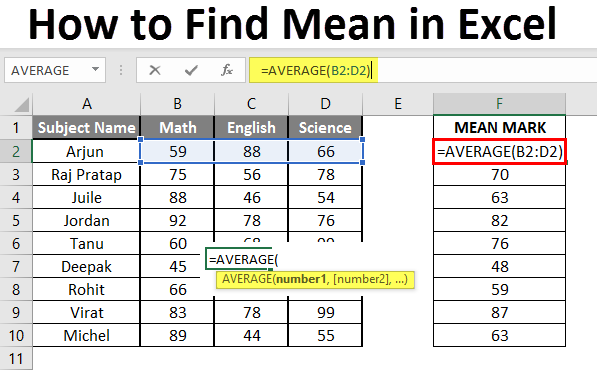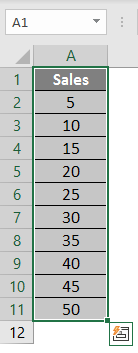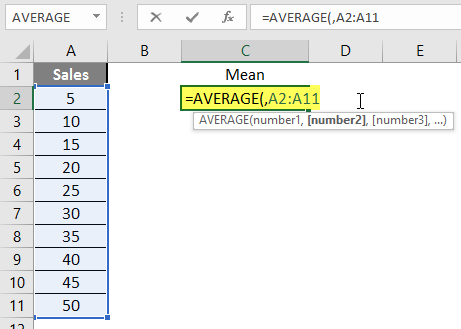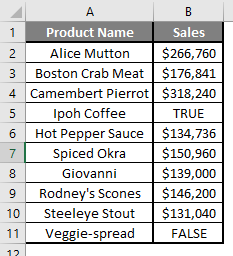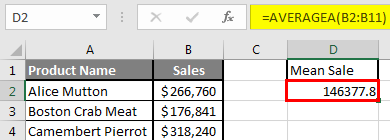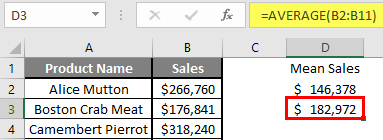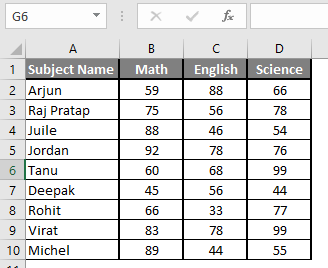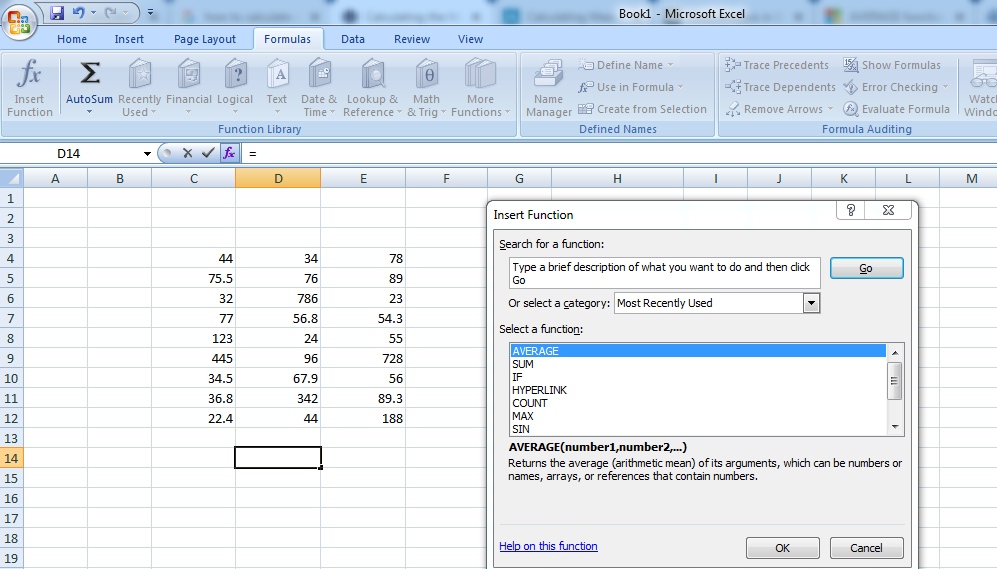How to Find Mean in Excel (Table of Content)
- Introduction to Mean in Excel
- Example of Mean in Excel
Introduction to Mean in Excel
The average function is used to calculate the Arithmetic Mean of the given input. It is used to do sum of all arguments and divide it by the count of arguments where the half set of the number will be smaller than the mean, and the remaining set will be greater than the mean. It will return the arithmetic mean of the number based on provided input. It is an in-built Statistical function. A user can give 255 input arguments in the function.
As an example, suppose there is 4 number 5,10,15,20 if a user wants to calculate the mean of the numbers then it will return 12.5 as the result of =AVERAGE (5, 10, 15, 20).
The formula of Mean: It is used to return the mean of the provided number where a half set of the number will be smaller than the number, and the remaining set will be greater than the mean.
The argument of the Function:
- number1: It is a mandatory argument in which functions will take to calculate the mean.
- [number2]: It is an optional argument in the function.
Examples on How to Find Mean in Excel
Here are some examples of how to find mean in excel with the steps and the calculation
You can download this How to Find Mean Excel Template here – How to Find Mean Excel Template
Example #1 – How to Calculate the Basic Mean in Excel
Let’s assume there is a user who wants to perform the calculation for all numbers in Excel. Let’s see how we can do this with the average function.
Step 1: Open MS Excel from the start menu >> Go to Sheet1, where the user has kept the data.
Step 2: Now create headers for Mean where we will calculate the mean of the numbers.
Step 3: Now calculate the mean of the given number by average function>> use the equal sign to calculate >> Write in cell C2 and use average>> “=AVERAGE (“
Step 3: Now, it will ask for a number1, which is given in column A >> there are 2 methods to provide input either a user can give one by one or just give the range of data >> select data set from A2 to A11 >> write in cell C2 and use average>> “=AVERAGE (A2: A11) “
Step 4: Now press the enter key >> Mean will be calculated.
Summary of Example 1: As the user wants to perform the mean calculation for all numbers in MS Excel. Easley everything calculated in the above excel example, and the Mean is 27.5 for sales.
Example #2 – How to Calculate Mean if Text Value Exists in the Data Set
Let’s calculate the Mean if there is some text value in the Excel data set. Let’s assume a user wants to perform the calculation for some sales data set in Excel. But there is some text value also there. So, he wants to use count for all, either its text or number. Let’s see how we can do this with the AVERAGE function. Because in the normal AVERAGE function, it will exclude the text value count.
Step 1: Open MS Excel from the start menu >> Go to Sheet2, where the user has kept the data.
Step 2: Now create headers for Mean where we will calculate the mean of the numbers.
Step 3: Now calculate the mean of the given number by average function>> use the equal sign to calculate >> Write in cell D2 and use AVERAGEA>> “=AVERAGEA (“
Step 4: Now, it will ask for a number1, which is given in column B >> there is two open to provide input either a user can give one by one or just give the range of data >> select data set from B2 to B11 >> write in D2 Cell and use average>> “=AVERAGEA (D2: D11) “
Step 5: Now click on the enter button >> Mean will be calculated.
Step 6: Just to compare the AVERAGEA and AVERAGE, in normal average, it will exclude the count for text value so mean will high than the AVERAGE MEAN.
Summary of Example 2: As the user wants to perform the mean calculation for all number in MS Excel. Easley, everything calculated in the above excel example and the Mean is $146377.80 for sales.
Example #3 – How to Calculate Mean for Different Set of Data
Let’s assume a user wants to perform the calculation for some student’s mark data set in MS Excel. There are ten student marks for Math, English, and Science out of 100. Let’s see How to Find Mean in Excel with the AVERAGE function.
Step 1: Open the MS Excel from the start menu >> Go to Sheet3, where the user kept the data.
Step 2: Now create headers for Mean where we will calculate the mean of the numbers.
Step 3: Now calculate the mean of the given number by average function>> use the equal sign to calculate >> Write in F2 Cell and use AVERAGE >> “=AVERAGE (“
Step 3: Now, it will ask for number1 which is given in B, C, and D column >> there is two open to provide input either a user can give one by one or just give the range of data >> Select data set from B2 to D2 >> Write in F2 Cell and use average >> “=AVERAGE (B2: D2) “
Step 4: Now click on the enter button >> Mean will be calculated.
Step 5: Now click on the F2 cell and drag and apply to another cell in the F column.
Summary of Example 3: As the user wants to perform the mean calculation for all number in MS Excel. Easley, everything calculated in the above excel example and the Mean is available in the F column.
Things to Remember About How to Find Mean in Excel
- Microsoft Excel’s AVERAGE function used to calculate the Arithmetic Mean of the given input. A user can give 255 input arguments in the function.
- Half the set of a number will be smaller than the mean, and the remaining set will be greater than the mean.
- If a user calculating the normal average, it will exclude the count for a text value, so AVERAGE Mean will bigger than the AVERAGE MEAN.
- Arguments can be number, name, range or cell references that should contain a number.
- If a user wants to calculate the mean with some condition, then use AVERAGEIF or AVERAGEIFS.
Recommended Articles
This is a guide to How to Find Mean in Excel. Here we discuss How to Find Mean along with examples and a downloadable excel template. You may also look at the following articles to learn more –
- FIND Function in Excel
- Excel Find
- Excel Average Formula
- Excel AVERAGE Function
Learn quick and simple ways to calculate mean in excel. Read the article to know how.
Excel is a widely popular program which is used to analyse and organize large amounts of data and information. Finding out the mean is one of the most important functions of analyzing data. But what is mean?
The mean is the average number when all of the data is added and divided by the number of data points. Let us know what the mean is, its uses and how to calculate the mean in Excel for your usage.
Uses For Mean in Excel
There are many uses for the mean in Excel. The mean is found by adding up all of the numbers in a set of data and dividing by the number of points that are added together. It tells you the typical value in a given set of information. Some ways you can use the mean in analyzing data:
- To find a standard midpoint for comparing individual data points.
- To determine quotas and key performance indicators (KPIs).
- To compare historical data.
- To guide project management and business strategy.
Specifying Mean Calculation Criteria in Excel
Here are some scenarios where you will need to use more specific mean formulas to know if the information should be included in the calculation:
- You want to include cells with values of zero or text. If you want to include cells with any data in your calculations, you would use the formula AVERAGEA.
- You want to include cells that meet specific criteria. If you only want to find the mean of certain information that is based on one criterion, you would use the formula AVERAGEIF. You might use this if you are trying to find the mean of every cell that doesn’t meet a quota or the mean salary over a certain pay grade.
- You want to include cells that meet several specific criteria. If you are trying to find the mean of information that meets two or more requirements, you would use the formula AVERAGEIFS. You might use this if you are trying to find the mean of cells that are within a certain number range.
There are many ways to calculate the mean of a data set. It depends on what you are trying to find in the data. Here is how to calculate the mean of an entire data set:
Example #1 – How to Calculate Mean in Excel In the Basic Way
Step 1: Open MS Excel from the start menu >> Go to Sheet1, where the user has kept the data.
Step 2: Create headers for the Mean where we will calculate the mean of the numbers.
Step 3: Calculate the mean of the given number by average function>> use the equal sign to calculate >> Write in cell C2 and use average>> “=AVERAGE (“
Step 4: Now, it will ask for a number1, which is given in column A >> there are 2 methods to provide input either a user can give one by one or just give the range of data >> select data set from A2 to A11 >> write in cell C2 and use average>> “=AVERAGE (A2: A11) “
Step 5: Press the enter key >> Mean will be calculated.
Example #2 – How to Calculate Mean In Excel if Text Value Exists in the Data Set
Let’s calculate the Mean if there is some text value in the Excel data set.
Step 1: Open MS Excel from the start menu >> Go to Sheet2, where the user has kept the data.
Step 2: Create headers for the Mean where we will calculate the mean of the numbers.
Step 3: Calculate the mean of the given number by average function>> use the equal sign to calculate >> Write in cell D2 and use AVERAGEA>> “=AVERAGEA (“
Step 4: It will ask for a number1, which is given in column B >> there is two open to provide input either a user can give one by one or just give the range of data >> select data set from B2 to B11 >> write in D2 Cell and use average>> “=AVERAGEA (D2: D11) “
Step 5: Click on the enter button >> Mean will be calculated.
Step 6: Just to compare the AVERAGEA and AVERAGE, in normal average, it will exclude the count for text value so the mean will high than the AVERAGE MEAN.
Example #3 – How to Calculate Mean In Excel for Different Sets of Data
Let’s assume a user wants to perform the calculation for a student’s mark data set in MS Excel. There are ten student marks for Math, English, and Science out of 100. Let’s see How to Find Mean in Excel with the AVERAGE function.
Step 1: Open MS Excel from the start menu >> Go to Sheet3, where the user kept the data.
Step 2: Now create headers for the Mean where we will calculate the mean of the numbers.
Step 3: Calculate the mean of the given number by average function>> use the equal sign to calculate >> Write in F2 Cell and use AVERAGE >> “=AVERAGE (“
Step 4: Now, it will ask for number 1 which is given in B, C, and D column >> there are two open to provide input either a user can give one by one or just give the range of data >> Select data set from B2 to D2 >> Write in F2 Cell and use average >> “=AVERAGE (B2: D2) “
Step 5: Now click on the enter button >> Mean will be calculated.
Step 6: Now click on the F2 cell and drag and apply to another cell in the F column.
Improve Article
Save Article
Like Article
Improve Article
Save Article
Like Article
The mean (also called average) of the data set is calculated by adding all the numbers in the data set and then dividing it by the total number of values in the data set. In this article, we will find out how to calculate the mean in excel.
Method 1: AVERAGE function:
In this method, we are going to use the AVERAGE function which returns the mean of the arguments. For example, the =AVERAGE(A1:A10) returns the average of the numbers in the range of A1 to A10.
Syntax:
AVERAGE(number1,[number2],...)
Here,
- number1 (Required): The first cell reference or number for which you want the average
- number2 (optional): Additional cell references or numbers for which you want the average. The maximum limit is 255.
Notes:
- arguments can either be numbers or names, ranges, or cell references that contain numbers.
- If the argument contains text or logical values or empty cells then those values are ignored. However, if the cell contains the value zero then it is included.
- if the argument contains error values or text that cannot be translated to numbers then it will cause errors.
- AVERAGE: This function returns the average of cells with any data (logical values or text representation of numbers)
- AVERAGEIF: This function is used to calculate the average of only the values that meet a single criterion.
- AVERAGEIFS: This function is used to calculate the average based on multiple criteria.
Example:
Let us apply the above formula on some rough data as shown below:
In the above example, we have used 4 different functions.
- =AVERAGE(c4:e12): Returns the average of the numbers in cells c4 to e12
- =AVERAGE(c4:f6,6): Returns the average of the numbers in cells c4 to f6 and the number 6.
- =AVERAGE(b4:b12, “sara”, c4:c12): Returns the average of the numbers in cells c4 to c12 by matching the name “sara” in the range b4 to b12.
- =AVERAGE(d4:d12,b4:b12,”sara”,g4:g12,”b”): Returns the average of numbers from cells d4 to d12 by matching two conditions i.e., name “sara” in range b4 to b12 and grade “b” in range g4 to g12.
Method 2: Using Keyboard shortcuts
In this method first, you need to select the cells for which you have to calculate the average. Then select the INSERT function from the formulas tab, a dialog box will appear.
Select the AVERAGE function from the dialog and enter the cell range for your list of numbers in the number1 box. For example, if you need values from column A and from row 1 to row 10 then simply enter A1:A10. You can also simply drag and drop the selected cells and click OK. The result will be shown in the cell you have selected.
Like Article
Save Article
The mean represents the average value in a dataset. It gives us a good idea of where the center of a dataset is located.
The standard deviation represents how spread out the values are in a dataset. It gives us an idea of how closely the observations are clustered around the mean.
Using only these two values, we can understand a great deal about the distribution of values in a dataset.
To calculate the mean of a dataset in Excel, we can use the =AVERAGE(Range) function where Range is the range of values.
To calculate the standard deviation of a dataset, we can use the =STDEV.S(Range) function, where Range is the range of values.
This tutorial explains how to use these functions in practice.
Technical Note
Both the STDEV() and STDEV.S() function calculate the sample standard deviation.
You can use the STDEV.P() function to calculate the population standard deviation if your dataset represents the entire population of values.
However, in most cases we’re working with sample data rather than an entire population so we use the STDEV.S() function.
Example 1: Mean & Standard Deviation of a Single Dataset
The following screenshot shows how to calculate the mean and standard deviation of a single dataset in Excel:
The mean of the dataset is 16.4 and the standard deviation is 9.13.
Example 2: Mean & Standard Deviation of Multiple Datasets
Suppose we have multiple datasets in Excel:
To calculate the mean and standard deviation of the first dataset, we can use the following two formulas:
- Mean: =AVERAGE(B2:B21)
- Standard Deviation: =STDEV.S(B2:B21)
Next, we can highlight cells B22:B23 and hover over the bottom right corner of cell B23 until a tiny + appears. We can then click and drag the formulas over to the next two columns:
Additional Resources
How to Calculate a Five Number Summary in Excel
How to Calculate the Interquartile Range (IQR) in Excel
How to Calculate the Standard Error of the Mean in Excel
This tutorial will explain and elaborate on how to calculate Mean in Excel along with easy steps and examples. Indeed Microsoft excel is designed to analyze and organize numerical data quickly.
For this reason measure of central tendency is a big part thus basically used to represent and identify the central position within the data provided or, more technically, the middle or center in a statistical distribution. Sometimes, they are also classified as summary statistics.
The three main measures of central tendency are Mean, Median and Mode. They all are valid measures of a central location, but each gives a different indication of a typical value, and under different circumstances, some measures are more appropriate to use than others.
Particularly, we will be focused on how to get the MEAN of supplied data
Mean formula in Excel
The mean function is one of the three main measure of central tendency. It is basically known as average of cells was calculated by adding up all the collection of data sets and dividing it by the number of counts.
These mathematical terms including median and mode have different ways of examining the set of data or numbers. Consequently, Excel provides built-in function determining these terms except range, which requires formula to obtain the output.
Furthermore, MEAN is one of the crucial functions in terms of analyzing data. Therefore it is not a waste when you know how to use it. It is helpful considering instances of finalizing the students’ grades or even product sales.
One more thing that MEAN or average function can do is to ignore cells omitting numbers and empty cells. But if you want to include empty cells or values specified as zero, you can use AVERAGEA function which is more likely the same.
The good thing about finding MEAN is that the function you’re gonna use is still available on the following; excel for Microsoft 365, excel 2010, excel 2016, excel 2019, and excel 2021.
Syntax of Mean
=Average(value1,[value2]...)
Return Value
Average of the set of numerical values
Arguments
value1: required its the values needed to calculate MEAN.value2:Optional.Values to calculate.
There are bunches of ways to calculate the MEAN of your data in your spreadsheet, it will depend on what data you are trying to exercise. So here are the simple steps to find your mean.
- Create the data you will use in your workbook.
Open your Microsoft Excel, and analyze what data you need. You can have any data such as order sales, student grades, employee salaries, or whatever suits your perspective. Make use of the columns and rows as it is favorable when doing hands-on take advantage to create your design and creativity.
- Reorganize your Excel spreadsheet as needed
If you imported data in your workbook reorganize those data and format it according to the requirements. Actually, this step is not required to finish since you are at hand making your data; it is up to you how you would like to rearrange the data.
- Select an empty cell to enter the mean formula
Calculating MEAN in your excel spreadsheet could be done on the same worksheet you’re analyzing. Select an empty cell so you will not lose any data in the worksheet. You can prefer to be at the bottom of the column or at the right side depending on what is easy for you.
- Press Enter to the formula to find the mean
After you created a formula, just hit enter key to completely see the Mean of your data.
As we have probably known the arithmetic mean is also understood as average. Thus let’s see how to calculate the average, will give few example formulas and instances to clearly understand it.
Basically, to get the mean of a group of numbers: {2,4,6,7, 8,10,12}.
Add them up and then divide the sum by the total number of set: {2,4,6,7, 8,10,12}/7=6
Take a look at this another sample:
Supposedly you are going to get the mean of Smith’s subjects’ scores.
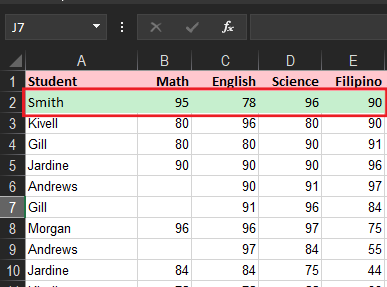
- To get the Mean use this formula: =AVERAGE(B2:E2)
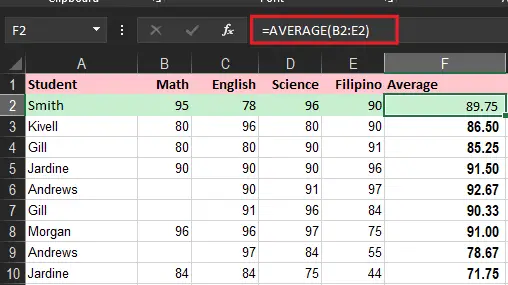
To get the average of only “Kivell” grades, use an AVERAGEIF formula:
=AVERAGEIF(A2:A10,"Kivell",C3:E3)
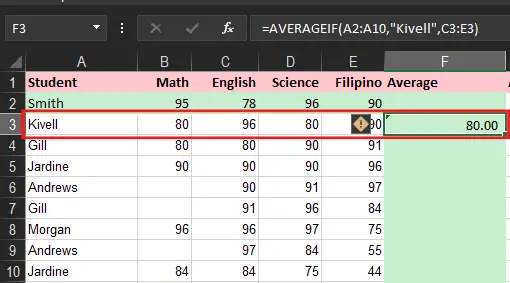
To calculate the mean of all the student’s averages
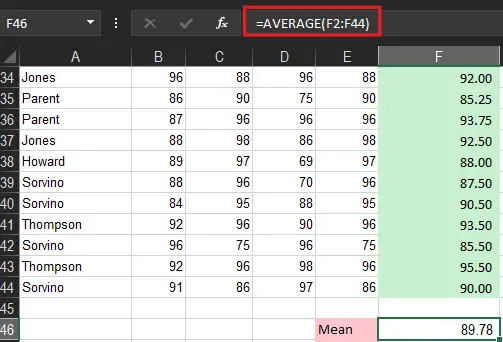
You can also enter your conditions in separate cells, and reference those cells in your formulas, like this:
=AVERAGEIF(A2:A44,A31,F2:F44)
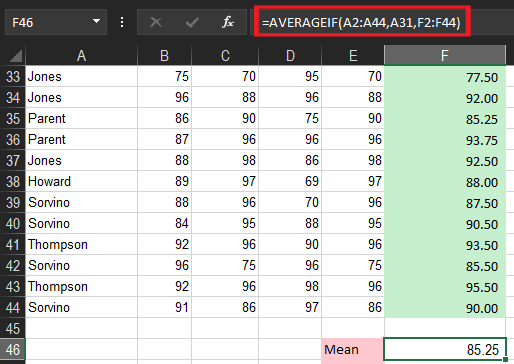
Reminders for Specifying MEAN calculation criteria
There are more often that you need to meet certain criteria in order to obtain the mean of data. Here are circumstances you will use more specific mean formulas to acquire specified information needed in the calculation.
- AVERAGEA: If you need to include text or zero value in your calculations.
- AVERAGEIF: Utilize this formula if you want to get the mean which needs to meet a single criterion of certain information. For instance, you need to find the cells that do not meet a quota or the passing average.
- AVERAGE IF: Finding MEAN which meets multiple criteria. This scenario implies two or more requirements need to find the MEAN of a sample data, thus use this formula to find the mean of a certain range.
What does ref mean on excel?
The #REF error you encountered when applying your formula is because the formula refers to a cell that is not valid. It always occurs when your cells used as references are pasted or deleted.
Summary
Recap on this tutorial How To Calculate Mean on Excel there are several ways to calculate MEAN from single criteria to two or more, including text values. Finding MEAN is similar to average and it uses the same function. Besides, it is beneficial in analyzing data in business, study, and daily activities.
There we have already done what MEAN is. For further clarification and suggestions feel free to leave your comment!
Thank you for reading!
-
1
Open Microsoft Excel. Click or double-click the Excel app icon, which resembles a green «X» on a green-and-white background.
- If you already have an Excel document that contains your data, double-click the document to open it in Excel 2007, then skip ahead to finding the mean.
-
2
Select a cell for your first data point. Click once the cell in which you want to enter your first number.
- Be sure to select a cell in a column that you want to use for the rest of your points.
Advertisement
-
3
Enter a number. Type in one of your data points’ numbers.
-
4
Press ↵ Enter. Doing so will both enter the number into your selected cell and move your cursor down to the next cell in the column.
-
5
Enter each of the rest of your data points. Type in a data point, press Enter, and repeat until you’ve entered all of your data points in the same column. This will make it easier to calculate the mean and the standard deviation of the list.
Advertisement
-
1
Click an empty cell. Doing so places your cursor in the cell.
-
2
Enter the «mean» formula. Type =AVERAGE( ) into the cell.[1]
-
3
Place your cursor in between the parentheses. You can press the left arrow key once to do this, or you can click in between the two parentheses in the text box at the top of the document.
-
4
Add your data range. You can input a range of data cells by typing the name of the first cell in the list of data, typing a colon, and typing in the last cell name in the column. For example, if your list of numbers goes from cell A1 through cell A11, you would type in A1:A11 in between the parentheses.
- Your completed formula should look something like this: =AVERAGE(A1:A11)
- If you want to calculate the mean of a few numbers (not a whole range), you can type each number’s cell name between the parentheses and separate the names with commas. For example, to find the mean of A1, A3, and A10, you would type in =AVERAGE(A1,A3,A10).
-
5
Press ↵ Enter. Doing so will run your formula, causing the mean of your selected values to display in your currently selected cell.
Advertisement
-
1
Click an empty cell. Doing so places your cursor in the cell.
-
2
Enter the «standard deviation» formula. Type =STDEV( ) into the cell.[2]
-
3
Place your cursor in between the parentheses. You can press the left arrow key once to do this, or you can click in between the two parentheses in the text box at the top of the document.
-
4
Add your data range. You can input a range of data cells by typing the name of the first cell in the list of data, typing a colon, and typing in the last cell name in the column. For example, if your list of numbers goes from cell A1 through cell A11, you would type in A1:A11 in between the parentheses.
- Your completed formula should look something like this: =STDEV(A1:A11)
- If you want to calculate the standard deviation of a few numbers (not a whole range), you can type each number’s cell name between the parentheses and separate the names with commas. For example, to find the standard deviation of A1, A3, and A10, you would type in =STDEV(A1,A3,A10).
-
5
Press ↵ Enter. Doing so will run your formula, causing the standard deviation value for your selected values to display in your currently selected cell.
Advertisement
Add New Question
-
Question
If the data set has 0 in it, should we include that when calculating mean? What about if the data set has blank cells; will these be considered zeroes when calculating mean?
If there is a 0 among your data set, it should be included when calculating the mean. Blank cells are not considered as zeroes in Excel, even if they are not excluded from the data range.
Ask a Question
200 characters left
Include your email address to get a message when this question is answered.
Submit
Advertisement
-
Changing a value in one of your data range’s cells will cause any connected formulas to refresh with an updated solution.
-
You can actually use the above instructions in any more-recent version of Excel (e.g., Excel 2016) as well.
Thanks for submitting a tip for review!
Advertisement
-
Double-check your list of data points before attempting to calculate mean or standard deviation.
Advertisement
About This Article
Thanks to all authors for creating a page that has been read 895,394 times.

